My Gratitude to My Teachers
This Thanksgiving I would like to honor two people who profoundly influenced the development of the Gokhale Method®.

Thanksgiving is a time to acknowledge those who lit your way. Image: Unsplash
Noëlle Perez-Christiaens (1925–2019) was my most important influence on this path, and my gateway to inputs from the eminent yoga teacher B.K.S. Iyengar (1918–2014), the French anatomist André Dalmas (1910–1999), and their numerous discoveries. Noëlle was a beautician by background, who developed an avid interest in yoga. This passion took her to India and B.K.S. Iyengar, where she had the good fortune to be one of Iyengar’s early students at a time when he had as few as four pupils gathered together in his living room for lessons. Later, Noëlle also had access to Iyengar’s medical yoga clinic.
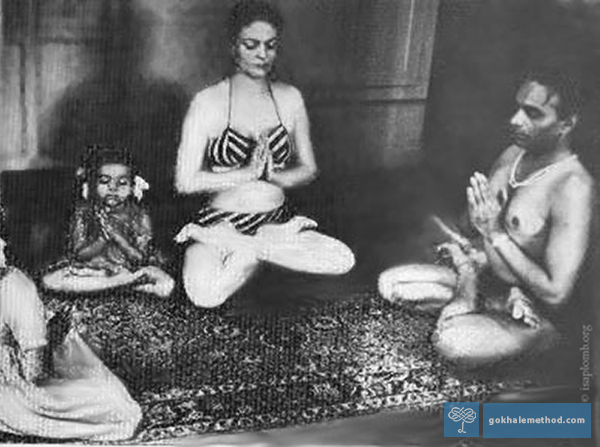
Noëlle studying with Iyengar in his home.
Noëlle was a witness to Iyengar’s process and absorbed numerous lessons from him that got passed down to her students. Many of these have found their way into the Gokhale Method:
1. Copying the body mechanics of functional people
With great insight, Iyengar told his students to “Walk behind the women in the Indian marketplace, and when your shadow looks like theirs you will have learned something.” The idea of mimicking the movement patterns of people in nonindustrial cultures fueled many of Noëlle’s discoveries and was a key part of my training. This kind of anthropological-visual mimicry makes its way into just about every class, article, and offering of the Gokhale Method. Based on our scientific understanding of the human visual cortex being very large and developed (this is reflected in the folk wisdom of “a picture is worth a 1,000 words”), our offerings rarely miss an opportunity to use photographs, video clips, or artwork to amplify the movement principles being taught.

A young woman walks through a marketplace, casting her distinctive shadow. Odisha, India.
2. Using props and innovating
Iyengar was the first yogi I know of to improvise using simple household props to better aid his students to achieve the shapes and poses he taught. He did this reluctantly because Indian culture values following tradition far more than improvisation (this has changed in recent years). But when his foreign students could not do what he wanted them to do, no matter how much he cajoled, exhorted, and ridiculed them (it’s a well-known joke that BKS stands for “bite, kick, shout”), he resorted to using blocks, ropes, towels, chairs, and whatnot to help the right things happen. In the West, we would regard his inventiveness as part of his genius, but he did these things almost apologetically.
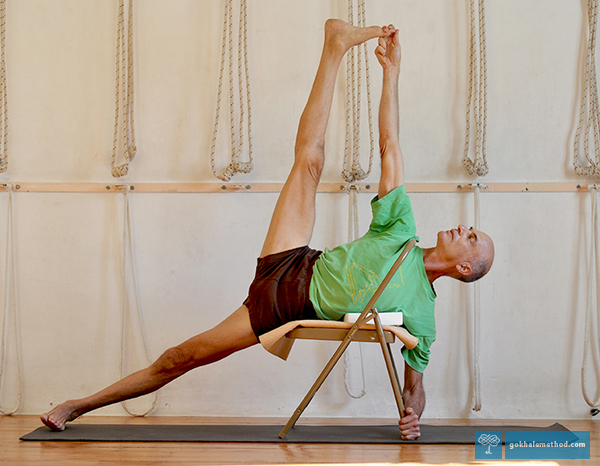
Iyengar Yoga can use extensive props, as in this version of Vasisthasana, or side plank pose. (Senior Iyengar Yogi, Eyal Shifroni). Image: Wikimedia
Noëlle was similarly inventive and improvisational. I remember being very impressed when, during a private session in Portugal where I was her translator, she gathered up some fallen blossoms and clumped them together to form makeshift metatarsal arch supports. Using props and tools to help students learn better/quicker/deeper plays a big role in the Gokhale Method. Thanks to modern tech, our learning aids include wearables ( SpineTracker™ and PostureTracker™), but we have also developed simpler props like rollers, cushions, wedges, and chairs.
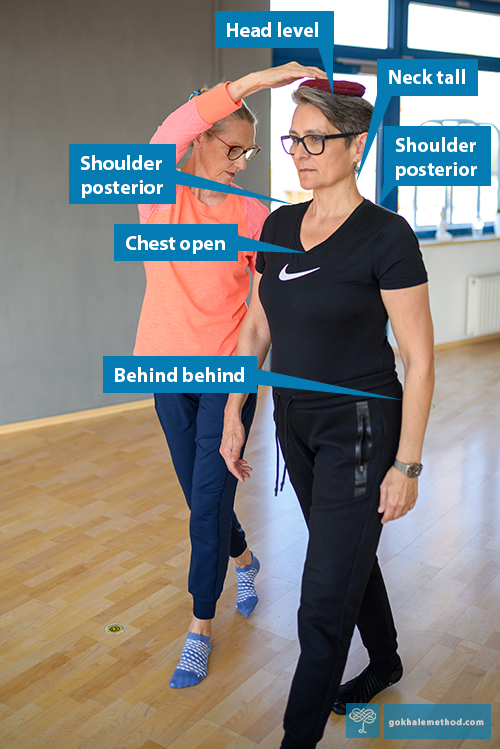
Gokhale Method teacher Clare Chapman helps a student to find healthy vertical alignment with a tall neck by using the Gokhale® Head Cushion.
3. The need for traction in the spine
Iyengar’s studio ended up having ropes and swings all over the place. My father, who suffered from sciatic pain, and who was introduced to Iyengar’s studio by my mother, was invariably sent to hang upside down from one of the yoga swings at the start of his lessons. Iyengar also used edges, surfaces, ropes, or plain old hands and feet to get students’ spines to relinquish some of their unhealthy compression. Noëlle’s genius was to incorporate these techniques into everyday life activities, for example, sleeping.
In the Gokhale Method, almost every student’s journey begins with traction. The two low-hanging juicy fruit techniques of stretchsitting and stretchlying are perfect starting points on any student’s journey. To facilitate stretchsitting, I invented the Stretchsit® Cushion and the Gokhale® Pain-Free Chair. Stretchlying doesn’t require props other than household pillows. By beginning with these two techniques, students often get relief from compression-related pain as early as Day 1, are better prepared to learn other techniques, and avoid flare-ups along the way.
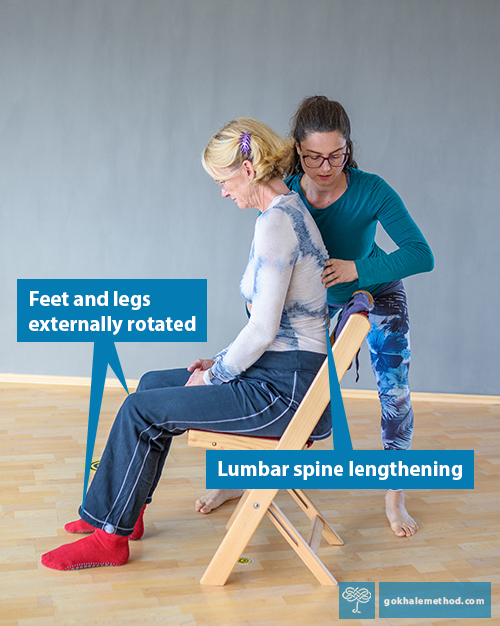
Gokhale Method teacher Sabina Blumauer guides a student preparing to stretchsit against a backrest with a Stretchsit® Cushion.
Though Iyengar and Noëlle were both opposed to systematizing and formalizing any of their teachings, I have discovered that for beginner students with back pain, it’s critical to precede any reshaping of the spine with gentle, sustained traction; otherwise one risks herniating a disc, pinching a spinal nerve, or triggering back spasms.
4. Modern Westerners need support to sit
An Indian in a traditional household eats all their meals sitting cross-legged unaided on the floor. It works if you grew up with it. It doesn’t work for people who grew up sitting at dining tables and using raised toilets. I’ve discussed the anatomic and developmental reasons for this elsewhere but Iyengar approached the problem empirically. When he saw his Western students struggling to sit upright, he came up with blocks on the floor and blanket-wedges on chairs. These simple solutions worked.
Geeta Iyengar, Iyengar’s eldest daughter, sitting on an improvised wedge of folded blankets. Image: thepracticeroom.in
I tried to come up with a more elegant and universal solution for years. It was, ironically, easier to build a wedge into the chair I designed than to come up with a free-standing wedge. The chair was designed a decade ago; the wedge only came into being this year.
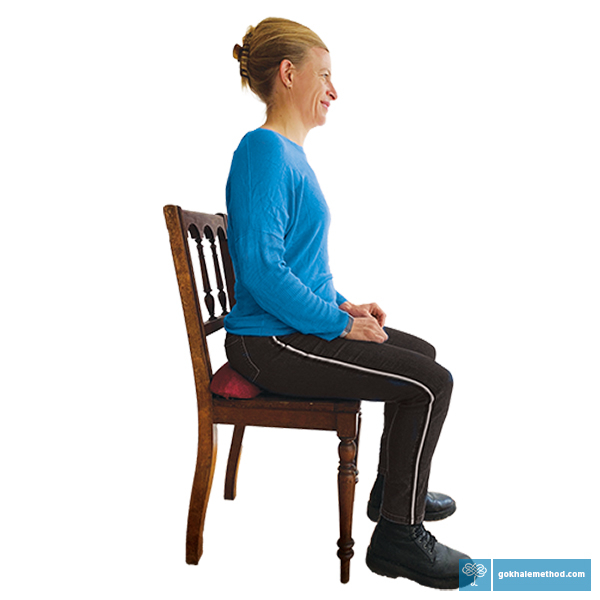
The Gokhale® Wedge offers a portable and elegant way to enable relaxed, upright sitting.
5. Using the breath to lengthen the torso
Pranayama is a branch of yoga that teaches numerous breathing techniques to address a variety of physical and mental states. Iyengar considered it an advanced practice and beginners were not introduced to pranayama techniques until they were well-advanced in their hatha yoga (asana/yoga pose) practice.
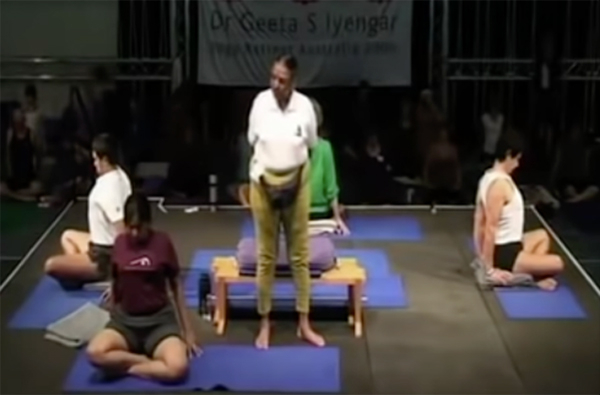
Pranayama, as taught by Iyengar, and here by his eldest daughter, Geeta, is a complex and deep practice. Dr Geeta Iyengar - How to Sit in Pranayama
Noelle brought the key technique of using the breath to lengthen the back into the basics of her Aplomb® teachings, using it both as a way of relaxing muscles and testing alignment. I have found this technique invaluable in myself and for teaching.
When the pelvis has healthy anteversion, the spine can stack well and be upright without tension. The relaxation of the erector spinae muscles allows the spine to lengthen with each breath. This breathing motion is highly therapeutic, improving circulation, mobility, and healing throughout the torso.
Many of our teachers have backgrounds in yoga and other traditions that include instruction in breathing. Our teacher community is in active discussion about how to bring additional insights about breathing into our offerings, using our signature filters of simplicity, science, history, and anthropology.
6. Never give up on a student
Iyengar was dogged in helping students make changes. He and Noëlle were extremely skilled in making seemingly magical things happen for pupils. They both used a carrot and stick approach; I prefer only carrots, but carry a similar, deep-seated conviction that a whole lot is possible with the right approach, techniques, language, and inspiration.
I'm immensely grateful for the teachings of Noëlle Perez and B.K.S. Iyengar at the beginning of my journey—they helped me leave my crippling back pain behind, and they inspired and shaped the Gokhale Method. There’s still a long journey ahead towards wider accessibility, more evidence-based research, and mainstream acceptance, but thanks to the head start provided by Noëlle’s and Iyengar’s contributions, I believe we are within reach of a solution for a problem that plagues far too many of us in the modern world.
Best next action steps for newcomers
If you would like to know which posture changes will help you be pain-free and functional, schedule an Initial Consultation, online, or in person.
You can sign up below to join one of our upcoming FREE Online Workshops. . .

Comments
Hi Esther, what a wonderful
Hi Esther, what a wonderful post! Thank you for the historical background - it's so helpful for trying to explain to friends who ask about what I am up to. It's not an easy subject to explain in few words. This was very helpful. xo
Add New Comment
Login to add commment
Login